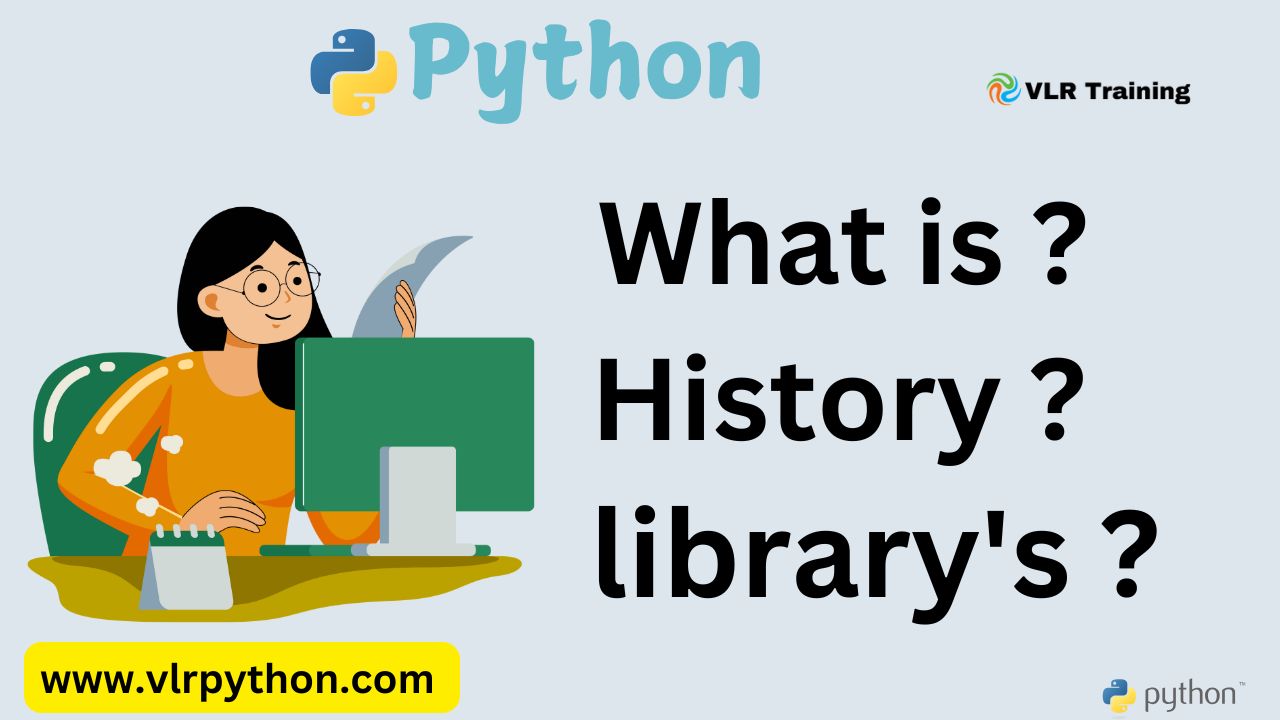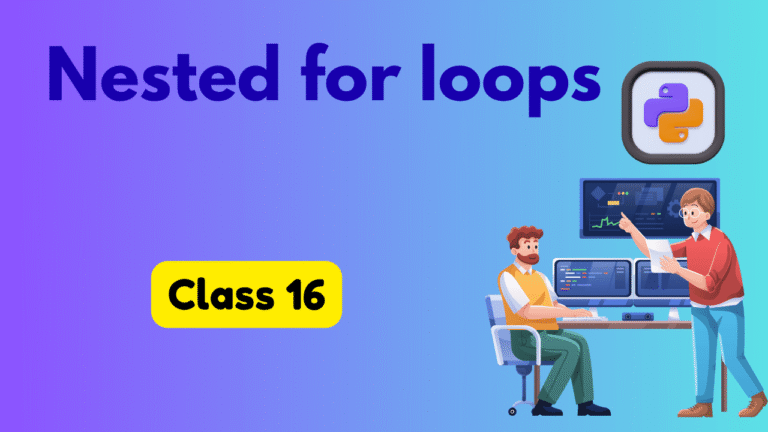Unlock the Power of Python: What is Python, History, Uses, & 7 Amazing Applications

What is Python and History of python, different sectors python used
Python is one of the most popular programming languages worldwide, known for its versatility and beginner-friendliness . From web development to data science and machine learning, Python has become an indispensable tool for developers and tech professionals across various industries . This blog post will explore what Python is, delve into what is python, history, and examine its diverse applications across different sectors.
What is Python?
Python is a high-level, interpreted, general-purpose programming language that prioritizes code readability with its clear syntax and use of indentation . It supports multiple programming paradigms, including procedural, object-oriented, and functional programming, making it a versatile choice for various development needs . What is Python is often used to build websites and software, automate tasks, and conduct data analysis . It’s a general-purpose language, meaning it can be used to create a variety of different programs and isn’t specialized for any specific problems .
Here are some of the key features that make Python unique:
- Interpreted: Python code is executed line by line, which simplifies debugging and testing as it allows developers to quickly identify and address errors .
- Easy-to-learn: Python’s syntax is similar to English, with an emphasis on readability, making it beginner-friendly and reducing the cost of program maintenance .
- Dynamically typed: Variable types are checked during runtime, providing flexibility in coding and allowing developers to write programs more quickly .
- High-level: Python abstracts away low-level details, such as memory management, enabling developers to focus on problem-solving rather than intricate technicalities .
- Object-oriented: Python supports object-oriented programming concepts, such as classes and objects, which promotes code reusability and modularity .
Python’s developer-friendly environment is further enhanced by its debugging features. It includes a source-level debugger that allows inspection of variables, evaluation of expressions, and setting breakpoints. Additionally, the ease of adding print statements to the source code facilitates quick and effective debugging .
Interestingly, Python plays a significant role in the development of other programming languages . Its influence extends beyond its own applications, highlighting its importance in the broader programming landscape.
Python’s accessibility and broad appeal are evident in its adoption by non-programmers, such as accountants and scientists, for everyday tasks like organizing finances . This demonstrates Python’s user-friendliness and its ability to empower individuals with limited programming experience.
History of Python
Python was conceived in the late 1980s by Guido van Rossum at Centrum Wiskunde & Informatica (CWI) in the Netherlands as a successor to the ABC programming language . Its implementation began in December 1989, with the first version, Python 0.9.0, released in February 1991 .
Python’s name is a nod to the British comedy group Monty Python’s Flying Circus, reflecting van Rossum’s appreciation for the show .
Python’s clear and concise syntax has been a key factor in its rising popularity, as it enhances readability and allows developers to express their ideas more effectively .
Here’s a timeline of Python’s evolution:
| Year | Version | Key Features |
|---|---|---|
| 1991 | Python 0.9.0 | Initial release |
| 1994 | Python 1.0 | Functional programming tools (lambda, map, filter, reduce) |
| 2000 | Python 2.0 | List comprehensions, garbage collection |
| 2008 | Python 3.0 | Addressed design flaws, backward-incompatible changes |
| 2020 | Python 2.7 | End-of-life |
Python’s open-source nature has been instrumental in its widespread adoption and development. A vast community of volunteer programmers has collaboratively developed thousands of modules, significantly expanding what is Python’s capabilities .
In 1999, Guido van Rossum outlined his goals for Python, which included:
- Creating an easy and intuitive language that is as powerful as major competitors.
- Making it open source, allowing anyone to contribute to its development.
- Ensuring the code is as understandable as plain English.
- Making it suitable for everyday tasks, enabling short development times .
These goals have been largely achieved, contributing to Python’s success and widespread adoption.
Python’s Evolution and Continuous Improvement
Python continues to evolve with ongoing development and the introduction of new features to enhance its performance and capabilities . Some notable improvements include what is python:
- JIT compiler: The Just-In-Time (JIT) compiler improves the execution speed of Python code by compiling frequently used code sections into machine code.
- Enhanced f-strings: F-strings provide a concise and readable way to embed expressions within strings, improving code clarity and efficiency.
- Per-interpreter GIL: The per-interpreter Global Interpreter Lock (GIL) enhances performance in multi-threaded applications by allowing separate interpreters to run concurrently.
These continuous improvements demonstrate Python’s commitment to staying relevant and meeting the evolving needs of developers and what is python.
Different Sectors Where Python is Used
Python’s versatility has led to its adoption across a wide range of industries and sectors. Here are some of the key areas where Python excels:
Web Development
Python is a popular choice for web development, especially for back-end development, where it handles server-side logic, data processing, and interactions with databases . Frameworks like Django and Flask provide developers with the necessary tools to build robust and scalable web applications .
- Django: A high-level framework that encourages rapid development and clean, pragmatic design. What is python it includes features like an object-relational mapper (ORM) for database interaction, a template engine for dynamic content generation, and a built-in admin interface . Django has been used in the development of popular applications like Instagram, YouTube, Spotify, and Dropbox .
- Flask: A microframework that provides the essentials for web development, giving developers flexibility and control over their applications. It’s lightweight and easy to learn, making it suitable for smaller projects and APIs .
Python’s scalability makes it suitable for large-scale web operations, as demonstrated by its extensive use in Google’s services, including its build system, app engines, search engines, and recommendation engines .
Data Science and Machine Learning
Python has become the leading language for data science and machine learning due to its extensive libraries and frameworks that simplify complex tasks such as data analysis, manipulation, visualization, and model building what is python and data science.
- NumPy: A fundamental library for numerical computing in Python, providing support for arrays, matrices, and mathematical functions .
- Pandas: A powerful library for data manipulation and analysis, offering data structures like DataFrames for efficient data handling .
- Matplotlib: A comprehensive library for creating static, interactive, and animated visualizations in Python .
- Scikit-learn: A popular library for machine learning, providing tools for classification, regression, clustering, dimensionality reduction, and model selection .
- TensorFlow: An open-source machine learning framework developed by Google, used for building and training deep learning models .
Automation and Scripting
Python’s simple syntax and extensive libraries make it ideal for automating tasks and writing scripts . It can be used to automate repetitive tasks, such as system administration, web scraping, and data processing .
Software Testing and Prototyping
Python is also valuable in software development for tasks like build control, bug tracking, and testing . What is python it allows developers to automate testing for new products or features, improving efficiency and reducing development time. Some Python tools used for software testing include Green and Requestium.
Education
Python’s beginner-friendliness and clear syntax make it a popular choice for teaching programming . Many educational institutions use Python as an introductory language for computer science courses, and its increasing use in education reflects its growing importance in the field and its accessibility to a wider audience, including non-programmers .
Startups
Python is a popular choice for startups due to its rapid development capabilities and its ability to handle various tasks, from web development to data analysis and machine learning . Its versatility allows startups to quickly build and iterate on their products, making it a valuable tool in the fast-paced startup environment.
Other Applications
Python is also used in various other sectors, including:
- Finance: For quantitative analysis, algorithmic trading, and risk management .
- Healthcare: For medical imaging analysis, predictive analytics, and electronic health record management .
- Retail and E-commerce: For recommendation systems, inventory management, and customer sentiment analysis and what is python.
- Game development: For building games and game development tools .
- Desktop applications: For creating cross-platform desktop applications .
Python Package Index (PyPI)
The Python Package Index (PyPI) is a repository of software for the Python programming language .What is python it allows users to find and install software developed and shared by the Python community, providing a vast collection of resources and tools that extend what is Python’s functionality.
Advantages and Disadvantages of Python
Like any programming language, Python has its strengths and weaknesses.
Advantages
- Easy to learn and use: Python’s syntax is clear and concise, making it beginner-friendly .
- Versatile: Python can be used for a wide range of applications, from web development to data science and machine learning .
- Large community: Python has a large and active community, providing support and resources for developers .
- Extensive libraries: Python has a vast collection of libraries that simplify development tasks . https://www.vlrpython.com/python/what-is-python-a-library-complete-list-of-python-libraries/
- Open-source: Python is free to use and distribute, even for commercial purposes .
- Ready-to-run: Python requires only simple code to be executed, making it efficient and easy to use .
Disadvantages
- Slower execution speed: As an interpreted language, Python can be slower than compiled languages like C++ or Java .
- High memory consumption: Python’s data structures can consume a significant amount of memory .
- Global Interpreter Lock (GIL): The GIL can limit the performance of multi-threaded programs by allowing only one thread to execute at a time, potentially affecting performance in CPU-bound applications .
Future of Python
Python’s future appears promising. Its versatility, ease of use, and strong community support ensure its continued growth and relevance in the ever-evolving tech landscape . Its longevity and widespread use across various industries make it a reliable and valuable tool for businesses, ensuring that investments in Python skills and development will likely remain relevant for a long time .
Here are some potential areas of growth for Python:
- Quantum computing: Python is well-suited for quantum computing with libraries like Qiskit and Cirq .
- Blockchain: Python is increasingly used in blockchain development, particularly for smart contracts and decentralized applications .
- Mobile development: Frameworks like Kivy and BeeWare enable mobile app development with what is Python .
- Embedded systems: Python’s use in embedded systems is expected to grow with the rise of the Internet of Things (IoT) .
Examples of best applications developed by python
Python is a versatile and widely-used programming language, and its impact can be seen in many popular applications we use every day. Here are some of the best applications developed with what is Python:
- Instagram: This social media giant, with over 2 billion monthly active users, relies on Python for its backend. Instagram uses the Django framework, written entirely in Python, to handle its massive user base and complex features like image and video sharing, filtering, and social interactions what is python.
- Spotify: The world’s leading music streaming service, Spotify, leverages Python for its backend services and data analysis. Python’s speed and advanced data analytics capabilities enable Spotify to power features like Discover Weekly and personalized radio stations, which rely heavily on user preferences and complex algorithms .
- Netflix: This streaming giant uses Python throughout its content lifecycle, from recommendation algorithms and security tools to its content distribution network. Python’s role in Netflix’s success highlights its scalability and ability to handle massive amounts of data and complex tasks .
- Dropbox: This popular cloud storage service, with over 700 million registered users, relies heavily on what is Python for both its server-side and desktop client applications. Python’s cross-platform compatibility and readability have been instrumental in Dropbox’s success .
- Uber: This ride-hailing giant uses Python for its core dispatch system, handling complex tasks like calculating ETAs, matching riders with drivers, and managing surge pricing. what is Python’s ability to handle large-scale data processing and mathematical computations makes it a perfect fit for Uber’s needs .
- Pinterest: This visual discovery platform, with over 400 million monthly active users, uses Python and a modified Django framework to manage its vast amount of image and video content, user interactions, and real-time updates .
- Reddit: The “front page of the internet” uses Python for its backend infrastructure, handling massive amounts of user-generated content, comments, and interactions. What is Python’s readability and extensive libraries make it a suitable choice for Reddit’s complex needs what is python and data science.
These examples demonstrate Python’s versatility and its ability to power some of the most popular and successful applications worldwide. Its ease of use, scalability, and extensive libraries make it a preferred choice for developers across various industries.
Conclusion
Python has become a dominant force in the programming world, empowering developers and tech professionals across various industries. Its versatility, beginner-friendliness, and extensive libraries make it a valuable tool for a wide range of applications, from web development and data science to automation and education. Python’s open-source nature and strong community support have fostered its continuous development and ensured its relevance in the ever-evolving technological landscape. With its adaptability and ongoing improvements, what is Python poised to remain a cornerstone of modern programming for years to come. Sources and related content in what is python.

